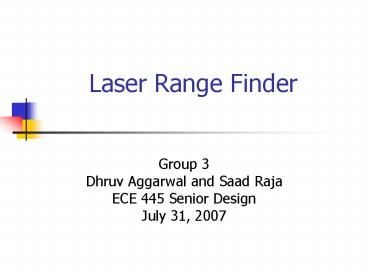Laser Range Finder - PowerPoint PPT Presentation
1 / 21
Title:
Laser Range Finder
Description:
A device which uses a laser beam to determine the distance to an object ... includes the phrase 'to avoid injuring others, their property, reputation, or ... – PowerPoint PPT presentation
Number of Views:2181
Avg rating:3.0/5.0
Title: Laser Range Finder
1
Laser Range Finder
- Group 3
- Dhruv Aggarwal and Saad Raja
- ECE 445 Senior Design
- July 31, 2007
2
Introduction
- A device which uses a laser beam to determine the
distance to an object - Common methods of range finding include
triangulation, multiple frequency phase shifting,
and time of flight.
3
Features
- USB wireless interface
- Modular design for extension options
- Generates a unique ID for each measurement which
can be labeled at the base station. - Quick and accurate measurements can be taken off
nearly all surfaces.
4
Laser Rangefinder Overview
- User can work Independently
- All the data is saved on computer which can be
reviewed later
5
Output Source
- Initial Plan was to use a VCSEL but due to very
low output power the idea was dropped - Two Semiconductor Laser diodes were used
- Steady output power 0.003 microW
- Pulsed output power 3.002 microW
- Wavelength Chosen 850nm
6
Detecting the Input
- IR Photosensor was used to detect the reflected
beam - Max sensitivity at 850nm
- Output signal was amplified
- using non-inverting amplifier
- with a gain of 10
7
The Mechanics of Reflection.
- Photosensor was placed right on top of the laser
diode so it could detect the maximum reflected
beam - Output from the sensor was amplified using a
differential amplifier with a gain of 10 - Output voltage from sensor was seen on the
oscilloscope when laser beam was reflected by
different materials
8
Oscilloscope Plots
- Reflection off White paper
- 10 cm 100cm
9
- Reflection off Cardboard
- 10cm 100cm
10
Voltage due to Reflection Vs Target distance
11
The Need for Speed
- Time Distance/Speed? Sounds simple
- Speed of light is 2.99792108 m/s
- In only one microsecond the passes 300 meters.
- A high resolution in place therefore demands
highest resolution in time.
12
Time to Distance Conversion
- TDC-GP2
- If the resolution has to be 1cm we already need a
time resolution of 67ps - 50ps resolution
13
Overcoming the timing limits
- Triggersignal from laser is connected to the
stop1 input - Detector signal connected to the stop2 input
- Any further loss in signal is compensated by
sampling
14
Wireless Data Transmission
- Xbee radios received the UART commands from
the PIC successfully - Enabled A/D conversion on one of the pins to
do distance measurement using the voltage method
15
User Interface
16
User Interface
- Coded using the Processing 1.0 programming
language. - Reads the data from the specified USB port and
extracts useful information from the data. - Gives a realtime distance output.
17
Ethical Considerations
- The IEEE code of ethics includes the phrase to
avoid injuring others, their property,
reputation, or employment by false or malicious
action , and we abide that - Need to be careful while working with the laser,
it shouldnt be pointed directly into the eyes - Our laser is a class 3B laser which will not
cause permanent eye damage unless there is direct
exposure for a long duration
18
Future Hardware Development
- Addition of a beamsplitter for more exact time
measurements - Use of the TDC-GPX for a resolution of 10ps
- Obtaining a good quality pulsed VCSEL for longer
distance measurements.
19
Future Software Development
- Obtaining a 2-D scan of the image by just
sweeping the laser over the object. - Uploading all data to a central server for
automated distance measurements.
20
Credits
- Professor Gary Swenson
- Professor Kent Choquette
- Tony Mangognia
- Dwayne Hagerman
- The folks at the part shop
21
Thank You































